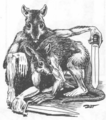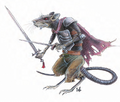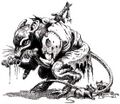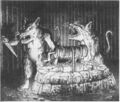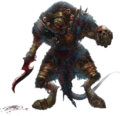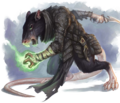Wererat: Difference between revisions
1d4chan>Nubnuber No edit summary |
imported>Administrator m 26 revisions imported |
||
| (6 intermediate revisions by 3 users not shown) | |||
| Line 75: | Line 75: | ||
Wererat VRG 1.jpg|Van Richten's Guide to Werebeasts | Wererat VRG 1.jpg|Van Richten's Guide to Werebeasts | ||
Wererat VRG 3.jpg | Wererat VRG 3.jpg | ||
Wererat | Wererat Realm of Terror.jpg|Realm of Terror | ||
Wererat CotN Werebeasts.jpg|Children of the Night: Werebeasts | |||
Wererat Dungeon 54.jpg|Dungeon #54 | Wererat Dungeon 54.jpg|Dungeon #54 | ||
Wererat PCS.jpg|Planescape | |||
Werewolf Wererat Werebear 3e.jpg|3e | Werewolf Wererat Werebear 3e.jpg|3e | ||
Werebear Wererat Dragon 410.jpg|Dragon #410 | Werebear Wererat Dragon 410.jpg|Dragon #410 | ||
Wererat 5e.png|5e | Wererat 5e.png|5e | ||
Wererat | Wererat B1.png|PF | ||
Wererat CC3.png | |||
Wererat SaS4.png | Wererat SaS4.png | ||
</gallery> | </gallery> | ||
[[Category: Monsters]] [[Category: Dungeons & Dragons]] [[Category: Ravenloft]] [[Category: Mystara]] [[Category: World of Darkness]] [[Category: Werewolf: The Apocalypse]] [[Category: Therianthropes]] | {{D&D-Therianthropes}} | ||
[[Category:Monsters]] | |||
[[Category:Dungeons & Dragons]] | |||
[[Category:Ravenloft]] | |||
[[Category:Mystara]] | |||
[[Category:World of Darkness]] | |||
[[Category:Werewolf: The Apocalypse]] | |||
[[Category:Therianthropes]] | |||
Latest revision as of 17:02, 23 June 2023

The Wererat is, as its name suggests, a therianthrope strain in which the victim can transform into the shape of either a normal sized rat, Giant Rat, a humanoid rat, or some combination thereof. It is the only therianthrope strain that has managed to approach the werewolf in popularity. They tend to embody the rat's symbolism as a sewer-dwelling scavenger, often being distinctly urban predators with a penchant for thievery or destructive behavior.
In Dungeons & Dragons[edit | edit source]
Wererats have a long history in Dungeons & Dragons. They debuted in OD&D, in the 1975 Greyhawk supplement. They've been in the Monster Manual for every edition of D&D since Advanced Dungeons & Dragons 1st edition through to Dungeons & Dragons 5th Edition, including in the Basic Set for BECMI and the Rules Cyclopedia. They also appear in D20 Modern.
An "Ecology of the Wererat" article appeared in Dragon Magazine #251.
The Patron God of the Wererats is Squerrik, who appeared in Monster Mythology and was then forgotten alongside the rest of his pantheon.
One oddity of the 2nd edition wererat's lore is that they dislike mating with each other, but the condition is only carried through the mother's side when interbreeding with humans; wererat fathers produce small but human children, and only wererat mothers who seduce human men give birth to new wererats. This might be a nod to the Fritz Leiber story "Fafhrd and the Gray Mouser: The Swords of Lankhmar", where one protagonist is seduced into bed with a human-rat hybrid who appears as a human woman with buck-teeth, a tail, and eight tits.
Wererats have a bit of notoriety from the example wererat being the deceptively low Challenge Rating of 2. This number is deceptive because they, like all werecreatures, possess a damage reduction of 10. While silver weapons to bypass this are relatively cheap, they still cost a good deal and aren't typically purchased at low levels by players not expecting to fight them. Their DR is enough that most builds can't even hurt them on average damage, but even a damage focused two handed weapon user is going to struggle to hurt it.
Wererat PCs?[edit | edit source]

Playable wererats have actually appeared multiple times. The first time was in Dragon Magazine #24, for Advanced Dungeons & Dragons 1st edition. This was followed by the Mystaran Wererat race-class for BECMI in PC4: Night Howlers, a monster class for Dungeons & Dragons 3rd Edition in Dragon #313, and a character theme (alongside the werewolf and werebear) for Dungeons & Dragons 4th Edition in Dragon #310. As a template with a given Level Adjustment, the base Lycanthrope template can be applied to any PC in a game that starts at level 3+.
Mystaran Wererats[edit | edit source]
According to PC4: Night Howlers, most wererats on Mystara are actually "beastweres" - they are normal rats who, having been infected with therianthropy, gained increased size, intelligence, and the power to assume partially or wholly human forms. The more powerful Greater Wererat is created when a human contracts rodent therianthropy from one of these.
Ravenloft Wererats[edit | edit source]
Next to werewolves, wererats have done the best of all therianthropes of the Demiplane of Dread; they are the only non-werewolf strain of therianthrope to get their own dedicated Domain, in the form of Richemulot (the wolfweres of Kartakass don't count since they're not technically therianthropes). You can tell because the domain's name is literally the French for "rich mouse" stuck together as one word.
Rat Kings[edit | edit source]
Not to be confused with large groups of rats that get their tails stuck together which, surprisingly, don't have a D&D monster based on them (but do in Pathfinder!). "Rat Kings" are a therianthrope strain native to the Demiplane of Dread, and one of the various werebeasts presented on the Ravenloft fansite "The Lonesome Road". As their name suggests, they are a more powerful strain of the common wererat, found only in the domain of Richemulot, from which they exert their influence over the wererat population and battle for dominance.
The human and beast aspects of a rat king resemble those of a common wererat. Indeed, much to the frustration of hunters, the rat king has an almost deliberately mundane appearance as both a human and a giant rat. When the rat king assumes its hybrid aspect, however, the horrid difference between the creature and a typical wererat becomes readily apparent. The hybrid aspect resembles an enormous, bloated rat, nearly the size of a bear, with subtle anthropomorphic features. Its relatively small limbs seem inadequate to move its massive bulk, but the creature is surprising fast and agile even in hybrid aspect.
In human aspect, a rat king is capable of speaking human tongues. However, some have been isolated from human social contact for so long that they devolve, forgetting how to communicate properly. Like most lycanthropes, the rat king can speak with animals of its phenotype while in beast or hybrid aspect. At all times, a rat king is accompanied by 4d6 normal rats and 1d10 giant rats, which will obey the creature's every command.
Combat: A rat king is rarely encountered in any form but its hybrid aspect. The creature's physical attacks can be surprisingly brutal. In a single round, a rat king can attack with both of its front claws for 1-4 points of damage each, and also bite for 3-8 points of damage. Anyone wounded in any way by a rat king has a 20% chance of being infected with a fatal disease (as the priest spell, cause disease). Unfortunately, this disease can only be cured by a heal spell. Those who are bitten by a rat king also have a 10% chance of contracting lycanthropy, although the phenotype of the victim is always the normal wererat variety. Wererats can only be struck by magical weapons of at least +2 enchantment, and are utterly immune to poison and diseases, even those of magical origin.
Rat kings have a powerful breath weapon in their hybrid aspect that can produce a variety of effects. A rat king can use its breath weapon three times per day, and must select a specific effect each time it does so: 1) A glob of slimy, bile-yellow fluid with the effects of a grease spell. The rat king can spit this glob up to ten feet away, where it spreads into a roughly 10' x '10' square pool. 2) A 30' radius cloud of glittering motes that acts as a sleep spell with a duration of three turns. 3) An 120' cube fog cloud that lasts for ten rounds. 4) A cloud of inky blackness that lasts for 16 rounds and acts as darkness, 15' radius. 5) A 15' radius dusty cloud that effects all those within as the itching effect of irritation. 6) A 15' radius cloud of pungent, white vapors that acts as the rash effect of irritation. 7) A 20' cube of greenish-yellow mist that acts as a stinking cloud. 8) A 10' cube of gaseous, sticky sap. All those caught within it are affected as if by a summon swarm spell. 9) A blast of seemingly normal hot air directed at single character. The victim is affected as if by a ray of enfeeblement.
No matter what aspect they are in, rat kings can use spider climb and putrefy food and drink at will, as a 6th-level spellcaster.
Habitat/Society: Individually, the wererats of Richemulot are moderately formidable creatures, but the true power of the lycanthropes lies in their organization and perchance for traveling in packs. Despite their evil natures, most wererats in the same pack have an unshakable loyalty to one another. Lacking some of the advantages of other lycanthropes, wererats rely on the mutual support of a pack to give them an advantage over other creatures, allowing them to rise to dominate subterranean environments. Occasionally, however, a wererat emerges who has little patience for pack life. Such individuals are pathologically selfish and egocentric, and resent their fellow wererats. Normally, these creatures are quickly singled out for ritual abuse by the pack, and more often than not are eventually murdered outright for their bad attitude. Rather than await this fate, some rogue wererats flee their packs and retreat into the deepest reaches of the Richemulot sewer systems.
Usually, these wererats are never seen from again, as they have a difficult time surviving on their own. Once in a great while, however, one of these creatures reemerges into the upper levels of the sewers, albeit somehow changed. Boasting a monstrous new hybrid form and formidable, seemingly magical powers, such lycanthropes are called rat kings by normal wererats. It is said that those wererats with the strength of will and cunning to survive by their own means are favored by the rodent god Squerrik. To show his favor, Squerrik sends a single rat to bite these powerful rogue wererats and infect them with a magical plague. If the wererat survives the feverish hallucinations and horrid symptoms of this disease, he is transformed into a rat king.
With their newfound power, rat kings quickly establish their dominance over local wererat packs. The wererats, for their part, accept the rulership of a rat king with little complaint, as more often than not, the rat king's intelligence and power lead to more food and treasure for everyone. Furthermore, rat kings quickly devour dissenting wererats to set an example. Indeed, there are few wererat packs anymore in Richemulot that are not under the command of a rat king (Jacqueline Reiner's minions are a prominent exception). The role of a rat king lies in strategizing, and the lycanthropes never engage in the surface activities of their wererat minions. The creatures prefer to wallow in some hidden chamber deep in the sewers, surrounded by hordes of rats and mountains of filth. Generally, there are also 2d6 wererats personally guarding the rat king at any given time.
Rather than being motivated by survival and racial superiority, rat kings are primarily interested in personal power and gratification. They see the manipulation of their weaker kin as the most reliable path to establishing their dominance over a subterranean region, and eventually the surface as well. Generally, however, the activities of the wererats themselves change very little when a rat king is calling the shots. Wererat packs under the aegis of a rat king are often more resolute and fearless, however, and have a morale of 14. Rat kings are uncomfortable around any creatures other than rodents, and they prefer the company of common and giant rats even to other wererats.
Unlike normal wererats, rat kings cannot produce more of their kind through breeding. Since Squerrik himself supposedly controls the number of rat kings in existence, there is rarely a problem with overpopulation of the powerful lycanthropes. Nonetheless, rat kings occasionally come into contact with one another, and the results are always violently hostile. Rat kings view another of their kind in their territory as a personal attack on their power. Hordes of rats and wererats can be sent to their deaths in the civil wars that inevitably erupt from such conflicts. The Richemuloise themselves usually suffer the most during such times, however, as wererat surface activities step up to significant levels.
Ecology: Rat kings are dangerous beings, but are rarely encountered first-hand by the very people they victimize. Their influence is felt throughout the cities of Richemulot through the murderous activities of their wererat minions.
World of Darkness[edit | edit source]
In the Old World of Darkness, wererats are known as the Ratkin, and are one of the fera that openly survived the genocidal wars that the werewolves fought against them. They are devoted most to the Wyld, and seek to topple the Weaver's webs (aka human civilisation) to defeat the Wyrm and spread chaos. They are, to put it lightly, the fear equivalent of fearmongering rednecks that run around in the streets screaming "The End is Near!", sign posts and everything, only replacing God with the Wyld.
In the New World of Darkness, the wererat concept was reworked into the Beshilu, or "Rat Hosts", which are body-stealing demonic rats that seek to rip down the Gauntlet between the physical world and the spirit world.
Gallery[edit | edit source]
-
Greyhawk Supplement
-
PC4
-
1e
-
2e
-
Dragon #251
-
Van Richten's Monster Hunting Guide
-
Van Richten's Guide to Werebeasts
-
Realm of Terror
-
Children of the Night: Werebeasts
-
Dungeon #54
-
Planescape
-
3e
-
Dragon #410
-
5e
-
PF
| The Therianthropes of Dungeons & Dragons | |
|---|---|
| Therianthrope | Laridian • Loup-garou • Loup du Noir • Lythari • Red Falcon • Seawolf • Selkie • Shifter • Swanmay • Thebestyn • Vodoni • Werebaboon • Werebadger • Werebat • Werebear • Wereboar • Werecat • Werecrocodile • Werefox • Werehyena • Werejackal • Werejaguar • Werekillerwhale • Wereleopard • Werelion • Werepanther • Wererat • Wereraven • Wereray • Wereseal • Weresnake • Wereshark • Werespider • Wereswine • Weretiger • Werewalrus • Werewolf |
| Antherions | Aranea • Song Dragon • Jackalwere • Nawidnehr • Wolfwere |
| Third Party | Werealligator • Wereanaconda • Werebunny • Werecheetah • Werecobra • Weremustela • Wereoctopus • Werepossum • Wereraccoon • Werestag • Werewolverine |


